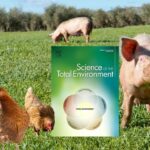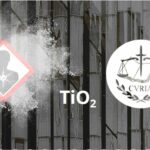
Titanium dioxide (TiO2) and the risk of cancer: the opinion of the Advocate General of the Court of Justice of the EU could back up classification
This is new episode in the long-running controversy surrounding the classification of titanium dioxide (TiO2) as a carcinogen if inhaled: on February 6, the Advocate General of the Court of Justice of the European Union (CJEU) delivered an opinion that gives France and the European Commission the upper hand in their battle against the lobbies. But the match is not over yet: the CJEU has yet to confirm whether it will refer the case to the EU General Court.
Reminders of previous episodes
“Category 2 carcinogen by inhalation”: this qualification doesn’t please titanium dioxide (TiO₂) manufacturers nor the many companies that use it – whether in paints, cosmetics, medicines*, textiles, plastics, packaging, etc.
Yet this is what the scientific experts at the European Chemicals Agency (ECHA) have ruled, leading to the classification of TiO2 in 2019, after a long battle between the industry and the French and European authorities1The French National Agency for Health Safety (ANSES) had initially requested a stricter classification (1B) in 2016. See our Infosheet Risks associated with titanium dioxide nanoparticles for more details..
Since then, the battle has continued… before the judges:
- In 2020, manufacturers and users of TiO₂ lodged an appeal with the General Court of the European Union requesting the annulment of this classification, arguing that the studies on which it was based were not sufficiently “reliable” and that titanium dioxide should not be considered as “intrinsically” dangerous.
- In 2022, the General Court sided with their arguments and issued a ruling to overturn the classification of TiO₂ as a category 2 carcinogen by inhalation2Cf. Industrials win (temporary) reversal of the classification of TiO₂ as a carcinogen, VeilleNanos, November 23, 2022.
- In 2023, the French government and the European Commission lodged appeals against this annulment3 Cf. Pending appeals from France and the European Commission, the classification of TiO2 stays, VeilleNanos, February 22, 2023, with the support of ECHA and the Dutch and Swedish governments.
- In November 2024, the European Commission, the French government and industries participated in a hearing on the appeals lodged by France and the European Commission.
Towards a cancellation… of the classification cancellation?
It took the Advocate General of the CJUE exactly two years to give her opinion on this case, which is several hundred pages long. Tamara Ćapeta delivered her opinion on the appeal lodged by the French and European authorities on February 6.
→ She proposes that the Court sets aside the 2022 judgment which sought to annul the classification of titanium dioxide – as requested by France and the European Commission – and refer the case back to the EU General Court.
Legal expertise and scientific controversy
The Advocate General shares the view of the public authorities and many legal experts4See, for example, our article of February 2023, for quotes from M. Weimer and M. Morvillo, legal experts at the University of Amsterdam, and from A. Ponce Del Castillo, legal expert and senior researcher at the European Trade Union Institute (ETUI), the research center of the European Trade Union Confederation (ETUC), on the fact that the General Court had exceeded its jurisdiction in terms of judicial review.
This central question is not new, and the General advocate recalls that Sheila Jasanoff, Professor of Sciences & Technology Studies in the USA, wrote in 1997 on this subject: “courts are not a forum for resolving scientific disputes definitively, but rather for doing justice on a case-by-case basis with the aid of all available scientific knowledge that meets threshold tests of relevance and reliability”.
In this case, Mrs. Ćapeta considers that the Court of First Instance should have deferred to the interpretation of scientific data by ECHA’s Risk Assessment Committee (RAC). Admittedly, in its view, the latter did not provide a sufficient explanation of one of the points contested by the industries: the agglomeration phenomenon which modifies the density of titanium dioxide particles having led to the development of tumors. But this is not enough to conclude that the RAC did not take all the relevant factors into consideration.
Another major point that the Advocate General rejects in the industry’s lobbying, taken up by the General Court, is the argument that titanium dioxide does not have the “intrinsic property” to cause cancer, on the grounds carcinogenicity only appears above a certain quantity of inhaled TiO2 and results from inflammation caused by the accumulation of these particles in the lungs, rather than by the substance as such. Here again, Mrs. Ćapeta disagrees with the opinion of the General Court, which had validated this point. She considers this to be too restrictive an interpretation of the European regulation on classification, labeling and packaging of substances and mixtures (CLP).
→ When inhaled in certain quantities, TiO2 particles have toxicological effects on the lungs that can lead to the development of tumors : this fact must be taken into account and not dismissed by alleging that the effect would be indirect.
Hélène Duguy, a lawyer with the NGO ClientEarth, agrees with the Advocate General’s interpretation: “Chemicals that are a danger to health in one way or another should remain within regulatory oversight provided by the CLP Regulation, and people who are exposed to them must continue to be informed so that they can protect themselves”.
In addition, the industries had attacked the reliability of one of the studies showing the development of tumors following exposure to TiO2. From a legal point of view, however, the Advocate General support public authorities’ view: they had argued that the General Court had ignored the general principle of “weight of evidence” which is enshrined in the CLP regulation, and instead introduced another concept, that of “decisive character” – which does not exist in the regulation, but which the General Court had used to invalidate the classification of TiO2 as a carcinogen.
Verdict expected within six months
The CJEU’s decision is now six months away. “We hope, of course, that the court’s decision will follow her recommendations,” says David Azoulay, senior attorney for the Center for International Environmental Law (CIEL). This decision will clarify the predominant role of the expert committees responsible for implementing European regulations, and perhaps – one can only dream – encourage manufacturers to be more diligent in providing information to these same committees. Since, as you will recall, TiO2 manufacturers have refused to provide the information requested by ECHA on TiO2 nanoforms for years“5In September 2014, nine titanium dioxide manufacturers appealed to ECHA’s “Board of Appeal” because they refused to provide ECHA with data on their TiO2 nanoforms as part of the risk assessment associated with titanium dioxide. In March 2017, they won their case on the grounds that the term “nanoform” was not defined in Reach… Cf. Decision of the board of appeal of the European Chemicals Agency, March 2017.
According to Chemical Watch, which has obtained this statistic from lawyers specializing in European law, the opinion of the Advocate General is generally followed by the Court in around 80% of cases. As indicated by the French authorities in 2023, the lodging of an appeal has a suspensive effect on the Court’s ruling: the harmonized classification will therefore continue to apply (at least) until the verdict.
In the meantime, we need to continue informing workers
In line with the adage “prevention is better than cure”, information on the potential danger of inhaling TiO2 particles must continue to be provided, especially when this TiO2 is in nanoparticle form. Without information, workers cannot take the necessary measures to protect themselves. Incidentally, this classification does not entail any restrictions on the use of TiO2: it merely requires that workers be alerted to the dangers of TiO2 powders and dusts below 10,000 nm.
* With regard to oral exposure of the general population, the European Commission’s decision on whether or not to extend the authorization of titanium dioxide (E171) in medicinal products is also expected this month6Cf. our fact sheet Towards a ban on titanium dioxide in cosmetics and medicinal products?
To be continued…

Other nano-related news
Next nano events

- Webinar presenting the actions taken, projects completed, and future prospects during the last three years. This event will be an opportunity to share scientific advances, industrial collaborations, and initiatives designed to strengthen competitiveness and safety in the nanomaterials sector.
- Organizers: NanoMesureFrance
- Speakers: Valérie Godefert & François-Xavier Ouf (LNE & NanoMesureFrance)
- Website: www….nanomesurefrance-webinar-…
- French Nutrition Days 2025
- Talks by Lauris Evariste and Bruno Lamas (INRAE) on December 11 and 12: Sex-dependent reduction in systemic immune response and resistance to bacterial infection after long-term exposure to food additive E551 (silica dioxide)
- Website: www.lesjfn.fr/
- Spectacle Art & Science – When science changes as it passes from mouth to mouth
- A unique participatory experience centered on the human factory of knowledge, where two fascinating worlds meet: nanomedicine, with its nanoparticles and cellular nanovectors, and quantum physics, with its superimposed states and complex systems.
- Organizers: Centre National de Compétences en Nanosciences (C’Nano), in collaboration with the Commissariat à l’Énergie Atomique (CEA), the Institut Polytechnique de Paris (IPP) and the Centre National de la Recherche Scientifique (CNRS).
- Speakers: Florence Gazeau, academician, physicist, research director at CNRS, and Charles Antoine, PhD in physics, lecturer at Sorbonne University, and Albert Moukheiber, PhD in neuroscience.
- Location: Théâtre de la Ville
- Website: https: //www.theatredelaville-paris.com/…/rencontres/nano-rumeurs…
Notes and references
- 1The French National Agency for Health Safety (ANSES) had initially requested a stricter classification (1B) in 2016. See our Infosheet Risks associated with titanium dioxide nanoparticles for more details.
- 2Cf. Industrials win (temporary) reversal of the classification of TiO₂ as a carcinogen, VeilleNanos, November 23, 2022
- 3Cf. Pending appeals from France and the European Commission, the classification of TiO2 stays, VeilleNanos, February 22, 2023
- 4See, for example, our article of February 2023, for quotes from M. Weimer and M. Morvillo, legal experts at the University of Amsterdam, and from A. Ponce Del Castillo, legal expert and senior researcher at the European Trade Union Institute (ETUI), the research center of the European Trade Union Confederation (ETUC),
- 5In September 2014, nine titanium dioxide manufacturers appealed to ECHA’s “Board of Appeal” because they refused to provide ECHA with data on their TiO2 nanoforms as part of the risk assessment associated with titanium dioxide. In March 2017, they won their case on the grounds that the term “nanoform” was not defined in Reach… Cf. Decision of the board of appeal of the European Chemicals Agency, March 2017
- 6Cf. our fact sheet Towards a ban on titanium dioxide in cosmetics and medicinal products?



